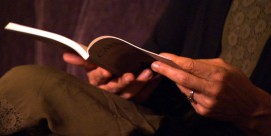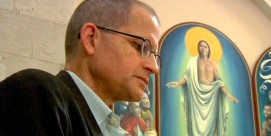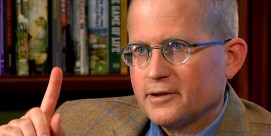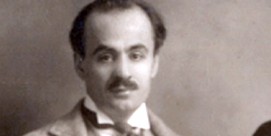In This Episode << SLIDE LEFT TO SEE ADDITIONAL SEGMENTS
The Things of This World
REVIEW ESSAY
The Things of This World
by David E. Anderson
For many poets, believers and nonbelievers alike, it is possible to talk about the religious imagination they bring to apprehending reality and describing the world.
Theologically, Christianity provides a language—and some doctrinal and historical metaphors or benchmarks—for two such imaginations: the sacramental and the dialectical. The first is broadly linked to Catholic ways of seeing and understanding God and the world, and the second, equally broadly and generally, to a Protestant sensibility.
 George Herbert |
Drawing on the work of Catholic theologian David Tracy, University of Notre Dame theology professor Mary Catherine Hilkert, in her book NAMING GRACE, gives a useful and succinct definition of the two imaginations: “The dialectical imagination stresses the distance between God and humanity, the hiddeness and absence of God, the sinfulness of human beings, the paradox of the cross, the need for grace as redemption and reconciliation…and the not-yet character of the promised reign of God. The sacramental imagination…emphasizes the presence of the God who is self-communicating love, the creation of human beings in the image of God…the mystery of the incarnation.”
Both imaginations reach deep into the history of English poetry. One can feel and touch the sacramental in the metaphors of the great religious poets such as John Donne and George Herbert. It perhaps most fully flowered in the poetry of Gerard Manley Hopkins, who characterized the incarnation in the lovely but surprising phrase “God’s infinity / Dwindled to infancy.” It is a poetry that closely observes and celebrates the material world as the arena or playground of the Lord.
Paul Mariani, a fine poet of this generation but perhaps better known for his biographies of Robert Lowell, Hart Crane, William Carlos Williams, John Berryman and, most recently, Hopkins, offers a good working definition of the sacramental imagination as language that “pays homage to the splendid grittiness of the physical as well as to the splendor and consolation of the spiritual.”
In a similar vein, literary critic and Gettysburg College English professor Peter Stitt, in his book THE WORLD’S HIEROGLYPHIC BEAUTY, a study of five mid-twentieth century American poets (Richard Wilbur, William Stafford, Louis Simpson, James Wright, and Robert Penn Warren), writes that all of them “love the physical world to such a degree that they sense within it some transcendent meaning, some hovering aura of belief.” Stitt notes that because Wilbur and Warren, for example, believe “that something sacred is to be found within reality, they do not feel required to abandon the physical in order to find the spiritual.” The sacramental imagination can, indeed, be summed up in the title of Wilbur’s great poem, “Love Calls Us to the Things of This World.”
The sacramental imagination has always been strong, but it seems particularly ascendant in contemporary poetry and criticism. Perhaps it is because there is something of a religious revival going on among intellectuals and artists not unlike that of a half-century ago; certainly there seems to be an abundance of religious themes in current film, fiction and music.
 William Cowper |
Unfortunately, however, that dominance makes it more difficult to hear and understand—or grant religious legitimacy to—the dialectical imagination. But poetry where the dialectical imagination is dominant, stressing the distance between God and the human and experiencing the world as a place where God is silent or absent, also has a long and distinguished pedigree in English poetry and hymnody.
Donald Davie suggests as much in his discussion of poet and hymnist William Cowper (1731-1800) in his introduction to THE NEW OXFORD BOOK OF CHRISTIAN VERSE. Davie notes of the first line—“Sometimes a light surprises”—of Cowper’s poem/hymn “Joy and Peace is Believing”: “One may have read this poem, or more probably sung it, many and many a time before realizing that the crucial word in it is the first: ‘Sometimes’—only sometimes, not always, not even very often!” The usual relationship between God and believer in Cowper’s imagination is distance rather than presence.
Similarly, in what is perhaps Cowper’s most famous poem, the first line (“Oh, for a closer walk with God”) stresses absence, an absence the second stanza only underscores: “Where is the blessedness I knew / When first I saw the Lord? / Where is the soul-refreshing view / Of Jesus and his word?”
In the twentieth century, one of the greatest poets of the dialectical imagination was the Welsh Anglican priest R.S. Thomas (1913-2000). Archbishop of Canterbury Rowan Williams called him “as influential as T.S. Eliot in religious circles,” and one critic designated Thomas “a poet of the Cross, the unanswered prayer, the bleak trek through darkness.” His powerful poem “The Porch” needs little explication:
Do you want to know his name?
It is forgotten. Would you learn
what he was like? He was like
anyone else, a man with ears
and eyes. Be it sufficient
that in a church porch on an evening
in winter, the moon rising, the frost
sharp, he was driven to his knees and for no reason
he knew. The cold came at him;
his breath was carved angularly
as the tombstones; an owl screamed.
He had no power to pray.
His back turned on the interior
he looked out on a universe
that was without knowledge
of him and kept his place
there for an hour on that lean
threshold, neither outside nor in.
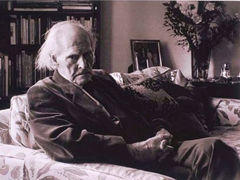 R.S. Thomas |
God’s absence, wrote Thomas, was for him like a presence “that compels me to address it without hope of a reply.”
One of the most difficult cases to critically deal with in trying to use religious categories is the poet who is an avowed nonbeliever but whose poetry is rich with religious resonances, themes, and iconography. Such a poet was Elizabeth Bishop (1911-1979), who was not a practicing Christian herself and was sometimes scathing in her dismissal of Christians as dogmatic and judgmental. But as Scripps College modern languages professor Cheryl Walker suggests in her fine and challenging, though sometimes uneven, study GOD AND ELIZABETH BISHOP, “She lived poetically, and in a sense religiously.”
Without using the language of the sacramental and dialectical, Walker’s study suggests that Bishop was a first-rate poet of the dialectical imagination who longed to perceive the world in sacramental terms, but was generally unable to. God’s presence was just not there. Like sacramental poets, such as her rough contemporary Richard Wilbur, Bishop was a close and careful observer of the material world, the local and the ordinary. Her observations revealed the absence of transcendence rather than the presence of God, but the poetry was no less religious for that perception.
Walker divides her study of Bishop into chapters exploring different Christian concepts and theological themes—time and eternity, the fall, love and longing, justice and charity, suffering, and “assent.” She draws out of Bishop’s poetry and prose the religious possibilities that are either on or just below the surface.
Walker is especially concerned to look at Bishop in light of the poet’s reading of Catholic mystics, especially St. John of the Cross. She is careful not to overwhelm the poems with interpretation or create for them a theological Procrustean bed, but she also candidly admits the poet’s dialectical imagination. In the poem “Squatter’s Children,” for example, about the lives of poor Brazilian people on the hills surrounding Rio de Janeiro, Walker sees that “we are once again confronted by the deus absconditus, the absent God who looks down on the children of the poor seemingly without much interest.” She identifies one of Bishop’s most moving poems, “One Art,” as “a religious poem without a God to offer grace.”
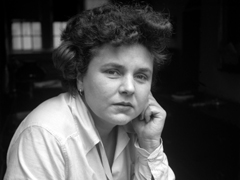 Elizabeth Bishop |
Even when one quibbles with some of the fine points of Walker’s reading, it is a rewarding and—for those who equate the dialectical imagination with a secular antagonism to things religious—surprising tour through the work of one of the premier poets of the middle of the last century. Bishop loved old hymns and the poetry of George Herbert, knew the Bible well, and read theology all her life. Still, the spiritual did not present itself to her “as a tenable substance,” observes Walker, quoting the French philosopher Emmanuel Levinas, “but, rather, through its absence.”
“To be of two minds was characteristic of Elizabeth Bishop,” Walker writes. “She could never quite relinquish the desire to believe, though a settled faith eluded her.” Precisely. And therein lies the tension between the sacramental imagination of presence and the dialectical imagination of absence. Both offer rich possibilities for a poetry that speaks powerfully of and to the modern world.
David E. Anderson is senior editor at Religion News Service. He wrote most recently for Religion & Ethics NewsWeekly on Charles Taylor’s A SECULAR AGE.

